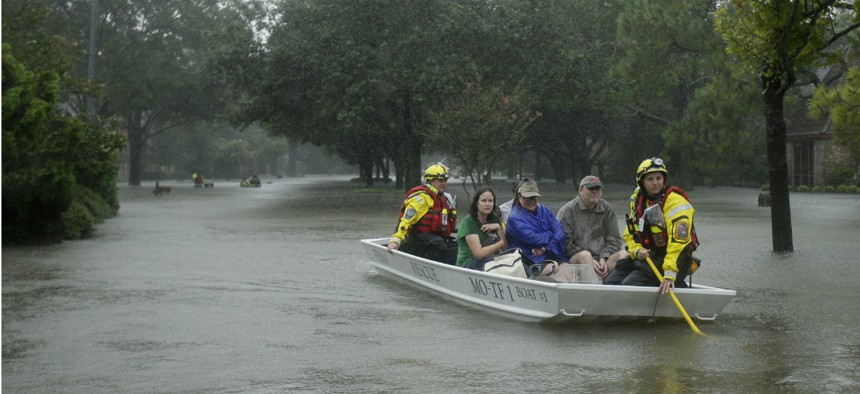8,500 Federal Employees Are Aiding the Harvey Response—Here’s What They’re Doing
More than a dozen agencies have deployed workers to help Texas and Louisiana.
Federal agencies across government have deployed employees to Texas and elsewhere in response to Hurricane Harvey, with more than 8,500 workers directly contributing to relief efforts.
Several agencies have been been taking action for days and weeks before Harvey made landfall Friday evening, through forecasting and preparatory work. The efforts intensified over the weekend, as heavy winds destroyed properties and prodigious rainfall flooded areas throughout Southeast Texas and parts of Louisiana. Now, more than a dozen federal agencies have sent staff and other resources either directly into the wake of the storm or to various coordinating centers facilitating the response.
The Office of Personnel Management reminded agencies of the governmentwide direct hiring authorities in place for certain types of jobs as agencies staff up for hurricane duties, while the General Services Administration told its federal partners about special disaster relief purchasing programs available and loosened restrictions on reimbursements and government purchase card use.
Throughout the process, the Trump administration has touted the seamlessness with which federal agencies are working both with each other and state and local authorities. Here is a look at the personnel and materials agencies have contributed to the effort so far:
- Federal Emergency Management Agency: FEMA is the lead federal agency overseeing the Harvey response. It has deployed more than 1,800 employees in support of those efforts, including 400 as part of urban search and rescue teams and more than 500 additional staffers in the affected region. It has established both national and regional response centers, located in Washington and Denton, Texas, respectively. Sixty-five FEMA employees have deployed to supplement emergency response communications needs. The agency has provided hundreds of thousands of liters of water and meals, thousands of tarps and dozens of generators. Additional Incident Management Assistance Teams continue to deploy. Brock Long, the agency’s administrator, told CNN on Sunday the agency was going to be in the region “for years.”
- Homeland Security Department: DHS, FEMA’s parent agency, has deployed 341 additional employees to supplement the efforts spearheaded by its component. They are serving as part of FEMA’s “surge capacity force” and are currently engaging in rapid strike training before joining the response teams on the ground.
- U.S. Coast Guard: The Coast Guard, another DHS component, has sent 420 personnel to South Texas, mostly for search and rescue operations. It will soon have 24 helicopters in Texas in the Houston and Galveston areas, and has nine teams conducting shallow water rescues.
- Health and Human Services Department: HHS already has 500 employees on the ground in Texas and Louisiana, with an additional 1,000 on alert for possible deployment. Those workers have helped distribute medical equipment and supplies, evacuate hospitals and evaluate damage to critical health infrastructure.
- Interior Department: Interior has 89 employees in Texas working on Harvey response through FEMA mission assignments. A variety of its component agencies are involved in the efforts, including the National Park Service, the Bureau of Safety and Environmental Enforcement and the U.S. Geological Survey. NPS is aiding in search and rescue missions including through the use of drones, BSEE helped evacuate personnel from offshore oil and gas platforms and USGS is providing information and imagery on storm surges and water heights.
- National Oceanic and Atmospheric Administration: NOAA was perhaps the first federal agency working on Harvey, with its National Hurricane Center tracking the storm for two weeks. Several offices scattered throughout the National Weather Service have provided forecasts and are embedded with emergency operations centers throughout the country. Some of those workers are dealing with their own flooded homes, said Chris Vaccaro, a NOAA spokesman. The agency’s Aircraft Operations Center aided computer modeling through its “hurricane hunter” devices. NOAA Navigation Response Teams are working with the U.S. Army Corps of Engineers to help reopen ports for commerce, while another air team has helped assess damage.
- Agriculture Department: While many agencies are involved in operations to save human lives, USDA is looking out for animals. The Animal and Plant Health Inspection Service is helping pets and their owners, assisting with zoos and breeders in the region and providing veterinary services for livestock. The rest of the department is waiting to provide long-term assistance such as food for shelters and farmers “dealing with losses right before harvest time,” a spokesperson said.
- Defense Department: NORTHCOM has led Defense’s Harvey response efforts, providing aircraft, fuel, generators and access to one of its airfields to the thousands of deployed National Guardsmen.
- Environmental Protection Agency: Many of EPA’s several hundred employees in its Dallas-based Region Six office have turned their attention to Harvey. Helping those employees “to manage response efforts and focusing on safety of those affected are our highest priorities,” said Liz Bowman, a spokeswoman for EPA Administrator Scott Pruitt. EPA has launched a Headquarters Emergency Operations Center and a National Incident Management Assistance Team is scheduled to arrive in Dallas on Tuesday. The agency’s work has included protecting superfund sites, developing plans for future testing of flood waters for contaminants and working with state agencies to assist with their responsibilities. EPA also faces long-term duties, such as ensuring that drinking water is safe and wastewater facilities are back up and running.
- Corporation for National and Communication Service: CNCS has deployed more than 225 AmeriCorps personnel to assist FEMA and Red Cross efforts.
- U.S. Postal Service: The mailing agency has closed or cut services at nearly two-dozen facilities in the affected region, and all retail and delivery operations in Houston are currently suspended. USPS has set up emergency operation centers to direct resources to handle mail and has sent teams to assess any damage at its facilities.
NEXT STORY: Nearly 60,000 Feds Impacted by Harvey




